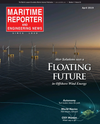
Page 36: of Maritime Reporter Magazine (April 2019)
Navies of the World
Read this page in Pdf, Flash or Html5 edition of April 2019 Maritime Reporter Magazine
AUTONOMOUS SHIPPING • THOUGHT LEADERSHIP tems require less maintenance and are on a high level; It is a complex situation. liable data, is anything but glamorous. alignment on all of the different players easier to build in redundancy.” With machinery functions it is much eas- “Not many owners/ship managers are at in the chain,” (from ships to ports to lo-
Grucza from Siemens agrees. “We ier because there you can have a de? ned the level of fully leveraging the power of gistics globally) … “that’s why you’re look at the power and propulsion plant set of failure modes, whereas with navi- data,” he observed, adding “We believe seeing some of the current developments more holistically as a system. When you gation you have an in? nite amount of in it, but it is a large effort to collect, being more regional focused, because get to autonomous vessels, I think that possibilities. That’s what makes it most clean up and effectively utilize data. It is quite simply you have fewer regulatory dynamic starts to change, too. For ex- complex.” a step-by-step, bottom up approach.” bodies that you need to get together and ample, how much of the electrical load “The next steps for Sea Machines are agree.” onboard a ship is for people and people both continuous feature development on What’s are the Challenges? “I think the main challenge is de? - support systems. That ratio for power for our existing products taken both from our “Technically I don’t think it is such nitely on the market side,” said Lepisto propulsion versus power for support sys- roadmap and from customer feedback,” a big challenge,” said Ando of MTI. “I of ABB. “The business case has to be in tems is going to change. In a workboat said Johnson. “We are also deep into the think the bigger challenge comes with place for the operators to move toward today, most of the power is for propul- advancement of vessel perception tech- regulation, insurance and liability, as unmanned ships or ships with less crews. sion, with some for crews & auxiliary nology, namely long-range machine vi- well as social acceptance.” As we discussed also, the regulatory systems. That ratio will change, with sion which utilizes large data sets and Ultimately getting stakeholders mov- needs to be in place, and that will start more for propulsion, the key technol- A.I. to “see” and interpret the domain ing in unison – from the owners and local and grow to national and interna- ogy is to view it systematically instead around an operating vessel by identify- operators to the ports and logistics pro- tional. With this, I also think there needs of just pieces and components. It’s about ing, classifying, and tracking traf? c and viders to the technology makers to the to be standardization within the industry robust, it’s about reliable, and power and obstructions. This Sea Machines tech- legislators to ? nance and insurance – is in regards to collision avoidance” for ex- propulsion are at the heart of the matter.” nology is currently being trialed aboard tantamount to moving maritime autono- ample.
But according to DNV GL’s Vartdal, an A.P. Moller-Maersk container ship in my forward, too. While most say that legal and ? nancial the electronics and sensor side – the the Baltic Sea.” Grucza of Siemens agrees. “I still see issues will pose stumbling blocks, John- navigation – has garnered the lion’s While the notion of ship traversing the regulatory and legal issues as the big son of Sea Machines cautions that the share of attention for a reason. “In terms waterways of the world yields some im- constraint to go fully autonomous. I technology to advance autonomy in the of complexity, the navigation part is the pressive artist renditions of the future, would assert that we are already seeing maritime space, for the long haul, is not most complex part to make autonomous MTI’s Ando maintains that the process many stages of autonomy in the infra- a tri? ing matter. because it requires situational awareness forward, fueled by huge amounts of re- structure today. I think it’s hard to get “Building technology that safely man-
Image: Kongsberg 36 Maritime Reporter & Engineering News • APRIL 2019
MR #4 (34-41).indd 36 4/2/2019 12:55:19 PM

 35
35

 37
37
